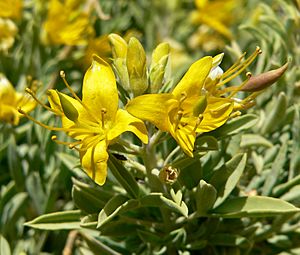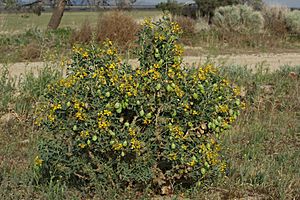Peritoma arborea facts for kids
Quick facts for kids Peritoma arborea |
|
|---|---|
 |
|
| Scientific classification | |
| Genus: |
Peritoma
|
| Species: |
arborea
|
| Synonyms | |
|
|
Peritoma arborea is a cool plant often called the bladderpod or bladderpod spiderflower. It's a type of shrub or bush that lives for many years. You can find it in the spiderflower family. This plant has bright yellow flowers that bloom all year long! It also has a special trick: it smells bad to keep insects from eating it.
Contents
Where Does the Bladderpod Grow?
The bladderpod plant loves sunny, dry places. You can often spot it growing along roadsides. It also thrives in sandy areas like desert dry washes and flat lands. This plant can grow up to about 4,200 feet high!
It is native to California and the Baja California Peninsula. This means it naturally grows in these areas. It likes different kinds of desert or brushy habitats there. You can find it in the western Mojave Desert and the Colorado Desert.
What Does the Bladderpod Look Like?
The bladderpod is a bushy plant that can grow from about 1.5 to 6.5 feet tall. It has many branches and is covered with tiny hairs. Its leaves usually have three equal parts, each about 0.5 to 1.75 inches long. These leaf parts are oval-shaped and pointed at the end.
Bladderpod Flowers
This plant produces many flowers at the ends of its branches for most of the year. Each flower has four bright yellow petals, about 0.3 to 0.5 inches long. There are also six long parts called stamens that stick out. These stamens are about 0.6 to 1 inch long.
Bladderpod Fruits
After the flowers, the plant grows interesting fruits. These fruits are like leathery capsules, shaped like a long oval. They are about 1 to 2.5 inches long and 0.4 to 1 inch wide. When they are new, they are smooth and green. As they get older, they turn light brown.
You can often see a plant with flower buds at the very top. Below them are open flowers. Even further down, you'll find the fruits that are growing, where the flowers used to be.
The old name for this plant, "Isomeris," has a cool meaning. "Iso" means "equal," and "meris" means "part." This refers to the stamens in the flower being all the same length.


